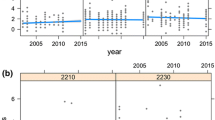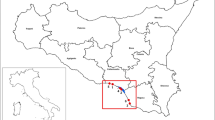Abstract
In coastal dunes, changes in plant composition and vegetation pattern can reveal processes such as plant succession, dune stabilization or reactivation. With that goal, I sampled plant species composition, topography and sand mobility along 4 parallel transects perpendicular to the coastline in the mobile dune system of Doñana. I used Split Moving Window to locate boundaries between plant communities along transects. To assess the main trends in variation, data of plant cover from all transects were subject to multivariate ordination analysis. Plant composition and geomorphological traits allowed to distinguish several stretches along all transects. Multivariate analyses reflected two different trends, plant succession and dune stabilization. High cover of Halimium halimifolium in the primary dune slack was consistent with the lack of new deposits of fresh sand. Growth of pine trees facilitated the colonization of the dune tail by H. halimifolium in a positive feedback. Although several studies have pointed out a decrease in the advance rates of dunes due to an increase in plant cover, the present results suggest that the increase in plant cover in the outer dunes is due to the stabilization of the secondary dune. Therefore, vegetation pattern evidenced a process of dune stabilization, which may produce loss of original plant communities and heterogeneity of dune landscapes.







Similar content being viewed by others
Abbreviations
- ᅟ:
-
Valdés et al. (1987)
- MRPP:
-
Multi-response permutation procedure
- SMW:
-
Split Moving Window
References
Allier C (1975) La vegetation psammophile du littoral de la Reserve Biologique de Doñana. In: Doñana. Prospección e inventario de ecosistemas, Monog. 18, ICONA, Ministerio de Agricultura, Madrid, pp 131–157
Arens SM, Slings QL, Geelen LHWT, van der Hagen HGJM (2013) Restoration of dune mobility in The Netherlands. Martínez ML, Fernández-Gallego JB, Hesp PA (editors) Restoration of coastal dunes, Springer, Berlin:107–124
Carter RWG, Wilson P (1990) The geomorphological, ecological and pedological development of coastal foredunes at Magilligan point, Northern Ireland. In: Nordstrom KF, Psuty NP, Carter RWG (eds) Coastal dunes: form and process. John Wiley and sons, London, pp 129–158
CEDEX (2013) Estudio de la dinámica litoral, defensa y propuesta de mejora en las playas con problemas: estudio de actuación del tramo de costa comprendido enetre las desembocaduras de los ríos Guadiana y Guadalquivir. MAGRAMA, Madrid, 169 pp
Cornelius JM, Reynolds JF (1991) On determining the statistical significance of discontinuities with ordered ecological data. Ecology 72(6):2057–2070. https://doi.org/10.2307/1941559
de Castro F (1995) Computer simulation of the dynamics of a dune system. Ecol Model 78(3):205–217. https://doi.org/10.1016/0304-3800(93)E0090-P
Crawford RMM (1989) Studies in plant survival. Ecological case histories of plant adaptation to adversity. Blackwell, Oxford
Dech JP, Maun MA (2005) Zonation of vegetation along a burial gradient on the leeward slopes of Lake Huron sand dunes. Can J Botany 83(2):227–236. https://doi.org/10.1139/b04-163
Dickinson KJM, Mark AF (1994) Forest-wetland vegetation patterns associated with a Holocene dune-slack sequence, Haast Ecological District, south western New Zealand. J Biogeogr 21(3):259–281. https://doi.org/10.2307/2845529
Doing H (1985) Coastal fore-dune zonation and succession in various parts of the world. Vegetatio 61(1-3):65–75. https://doi.org/10.1007/BF00039811
Doody JP (ed) (2008) Sand dune inventory of Europe, 2nd Edition. National Coastal Consultants and EUCC-The Coastal Union edn in association with the IGU Coastal Commission 142 pp
Feagin RA, Wu XB, Smeins FE, Whisenant SG, Grant WE (2005) Individual versus community level processes and pattern formation in a model of sand dune plant succession. Ecol Model 183(4):435–449. https://doi.org/10.1016/j.ecolmodel.2004.09.002
Fenu G, Carboni M, Acosta ATR, Bacchetta G (2012) Environmental factors influencing coastal vegetation pattern: new insights from the Mediterranean Basin. Folia Geobotanica 48(4):493–508. https://doi.org/10.1007/s12224-012-9141-1
Gallego Fernández JB, Muñoz-Reinoso JC, García Novo F (2009) Long term study of Pinus pinea L. forest in the mobile dunes of Doñana National Park, SW Spain. 10th international coastal symposium, book of abstract, Lisbon
García Novo F, Merino J (1997) Pattern and process in the dune system of the Doñana National Park, southwestern Spain. In: van der Maarel E (ed) Ecosystems of the world 2C. Dry coastal ecosystems, Elsevier, Amsterdam, pp 453–468
García Novo F, Ramírez L, Torres A (1976) El sistema de dunas de Doñana. Naturalia Hispanica 5:1–56
Granados Corona M (1987) Transformaciones históricas de los ecosistemas del Parque Nacional de Doñana, PhD Thesis, Universidad de Sevilla, 485 pp+append
Granados Corona M, Martín Vicente A, García Novo F (1987) Evolución conjunta del paisaje y su gestión. El caso del Parque Nacional de Doñana. Estudios Territoriales 24:183–197
Grootjans AP, Hartog PS, Fresco LFM, Esselink H (1991) Succession and fluctuation in a dune wet slack in relation to hydrological changes. J Veg Sci 2(4):545–554. https://doi.org/10.2307/3236037
Levin N, Kidron GJ, Ben-Dor E (2008) A field quantification of coastal dune perennial plants as indicators of surface stability, erosion or deposition. Sedimentology 55:751–772
Ludwig JA, Cornelius JM (1987) Locating discontinuities along ecological gradients. Ecology 68(2):448–450. https://doi.org/10.2307/1939277
Luna MCM, Parteli EJR, Durán O, Herrmann HJ (2011) Model for the genesis of coastal dune fields with vegetation. Geomorphology 129(3-4):215–224. https://doi.org/10.1016/j.geomorph.2011.01.024
Maun MA, Perumal J (1999) Zonation of vegetation on lacustrine coastal dunes: effects of burial by sand. Ecol Lett 2(1):14–18. https://doi.org/10.1046/j.1461-0248.1999.21048.x
McCune B, Grace JB (2002) Analysis of ecological communities. MjM Sofware Design, Oregon, 300 pp
Mielke PW Jr (1991) The application of multivariate permutation methods based on distance functions in the earth sciences. Earth-Sci Rev 31:55–71
Muñoz-Pérez JJ, López de San Román-Blanco B, Gutiérrez-Mas JM, Moreno L, Cuena GJ (2001) Cost of beach maintenance in the Gulf of Cadiz (SW Spain). Coast Eng 42(2):143–153. https://doi.org/10.1016/S0378-3839(00)00054-5
Muñoz-Reinoso JC (2001) Vegetation changes and groundwater abstraction in SW Doñana, Spain. J Hydrol 242(3-4):197–209. https://doi.org/10.1016/S0022-1694(00)00397-8
Muñoz-Reinoso JC (2003) Juniperus oxycedrus Ssp. macrocarpa in SW Spain: ecology and conservation problems. J Coast Conserv 9:113–122
Muñoz-Reinoso JC (2009) Boundaries and scales in shrublands of the Doñana biological reserve, southwest Spain. Landsc Ecol 24(4):509–518. https://doi.org/10.1007/s10980-009-9325-0
Muñoz-Reinoso JC, de Castro F (2005) Application of a statistical water-table model reveals connections between dunes and vegetation at Doñana. J Arid Environ 60(4):663–679. https://doi.org/10.1016/j.jaridenv.2004.07.006
Muñoz-Reinoso JC, Jiménez B, Ruíz A, Trillo M, Yanes A (2000) Respuesta del enebro marítimo al enterramiento. Granada, Resúmenes del Simposio de la AEET Aspectos funcionales de los ecosistemas mediterráneos
Muñoz-Reinoso JC, Rodríguez JL (2013) Datos para la plantación del enebro marítimo en sistemas dunares. In: Martínez-Ruíz C, Lario Leza FJ, Fernández-Santos B (eds) Avances en la restauración de sistemas forestales. Técnicas de implantación, SECF-AEET, Madrid, pp 163–168
Ojeda J, Vallejo I, Malvarez GC (2005) Morphometric evolution of the active dune system of the Doñana Nacional Park, southern Spain (1977-1999). J Coastal Res, Special Issue 49:40–45
Oosting HJ, Billings WD (1942) Factors effecting vegetational zonation on coastal dunes. Ecology 23(2):131–142. https://doi.org/10.2307/1931081
Provoost S, Laurence M, Jones M, Edmondson SE (2011) Changes in landscape and vegetation of coastal dunes in northwest Europe: a review. J Coast Conserv 15(1):207–226. https://doi.org/10.1007/s11852-009-0068-5
Psuty NP (2004) The coastal foredune: a geomorphological basis for regional coastal dune development. In: Martínez ML, Psuty NP (eds) Coastal dunes: ecology and conservation. Ecological studies, vol 171. Springer-Verlag, Berlin, pp 11–27
Ranwell DS (1972) Ecology of salt marshes and sand dunes. Chapman, London
Raventós J, De Luis M, Gras MJ, Čufar K, González-Hidalgo JC, Bonet A, Sánchez JR (2001) Growth of Pinus pinea and Pinus halepensis as affected by dryness, marine spray and land use changes in a Mediterranean semiarid ecosystem. Dendrochronologia 19:211–220
Rhind P, Jones R, Jones L (2013) The impact of dune stabilization on the conservation status of sand dune systems in Wales. In: Martínez ML, Fernández-Gallego JB, Hesp PA (eds) Restoration of coastal dunes. Springer, Berlin, pp 125–143
Rivas Martínez S, Costa M, Castroviejo S, Valdés E (1980) La vegetación de Doñana (Huelva, España). Lazaroa 2:5–190
Rodríguez-Ramírez A, Morales JA, Delgado I, Cantano M (2008) The impact of man on the morphodynamics of the Huelva coast (SW Spain). J Iberian Geol 34:313–327
Tsoar H (2005) Sand dunes mobility and stability in relation to climate. Physica A 357(1):50–56. https://doi.org/10.1016/j.physa.2005.05.067
Turner MG, Dale VH, Gardner RH (1989) Predicting across scales: theory development and testing. Landsc Ecol 3(3–4):245–252. https://doi.org/10.1007/BF00131542
Valdés B, Talavera S, Galiano EF (1987) Flora vascular de Andalucía Occidental. Ketres Editora, Barcelona
Vallejo I (2007) Caracterización geomorfológica y análisis de la evolución reciente del sistema de dunas activas del Parque Nacional de Doñana (1956–2001). PhDThesis, Universidad de Sevilla, 468 pp
Vallejo I, Márquez J (2006) Doñana active dune system: an example of fragile equilibrium ecosystem in the Mediterranean environment. Publicationes Instituti Geographici Universitatis Tartuensis 101:31–38
van der Maarel E (1997) Coastal dunes: pattern and process: zonation and succession. In: van der Maarel E (ed) Dry coastal ecosystems, general aspects (ecosystems of the world 2C). Elsevier, Amsterdam, pp 505–517
van der Maarel E, Leertouwer A (1967) Variation in vegetation and species diversity along a local environmental gradient. Acta Bot Neerl 16:1–11
van Leeuwen CG, van der Maarel E (1971) Pattern and process in coastal dune vegetations. Acta Bot Neerl 20(1):191–198. https://doi.org/10.1111/j.1438-8677.1971.tb00699.x
Wilson JB, Sykes MT (1999) Is zonation on coastal sand dunes determined primarily by sand burial or salt spray? A test in New Zealand dunes. Ecol Lett 2(4):233–236. https://doi.org/10.1046/j.1461-0248.1999.00084.x
Yura H, Ogura A (2006) Sandblasting as a possible factor controlling the distribution of plants on a coastal dune system. Plant Ecol 185(2):199–208. https://doi.org/10.1007/s11258-005-9095-y
Zunzunegui M, Ain-Lhout F, Díaz Barradas MC, Álvarez-Cansino L, Esquivias MP, García Novo F (2009) Physiological, morphological and allocation plasticity of a semi-deciduous shrub. Acta Oecol 35(3):370–379. https://doi.org/10.1016/j.actao.2009.02.004
Acknowledgements
This research was carried out within the framework of the “Conservation Program of Maritime Juniper Woodlands (2002–2006)”. I thank the funds provided by the Consejería de Innovación of the Andalusian Government through the Technology Transfer Office for the development of the research (2009, 2010). I also thank Dr. de Castro, Dr. Fernández-Alés and an anonymous reviewer for their comments on the manuscript.
Author information
Authors and Affiliations
Corresponding author
Rights and permissions
About this article
Cite this article
Muñoz-Reinoso, J.C. Doñana mobile dunes: what is the vegetation pattern telling us?. J Coast Conserv 22, 605–614 (2018). https://doi.org/10.1007/s11852-018-0594-0
Received:
Revised:
Accepted:
Published:
Issue Date:
DOI: https://doi.org/10.1007/s11852-018-0594-0




